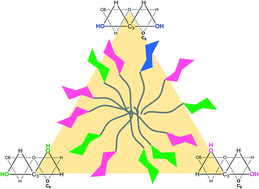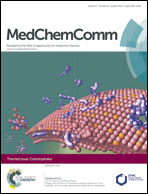Exploring the meaning of sugar configuration in a supramolecular environment: comparison of six octyl glycoside micelles by ITC and NMR spectroscopy†
Abstract
A series of octyl α- and β-glycosides of the manno- galacto- and gluco-series were synthesized and employed in formation of homo- and hetero-micelles in water. Critical micelle concentrations (cmc), thermodynamic quantities of demicellation and, to some extent, the hydrodynamic radii of glycomicelles were determined by isothermal titration calorimetry (ITC) and diffusion NMR studies. The goal of this work was to determine the significance of anomeric configuration as well as of epimerisation at the sugar ring for supramolecular features of the respective glycoside. A new projection of glycoside structures is proposed to facilitate interpretation of structure–property relationships in this regard.


 Please wait while we load your content...
Please wait while we load your content...